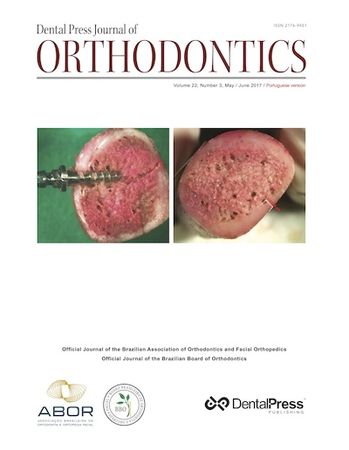
Seu carrinho está vazio!
Angle Class III malocclusion is characterized by an anteroposterior dental discrepancy with or without anteroposterior and vertical skeletal changes. Patients usually seek orthodontic treatment because facial appearance is compromised in most cases. The present study describes the clinical case of a 12-year and 6-month-old girl in her final stage of pubertal growth presenting Class III malocclusion with anteroposterior and vertical discrepancies. Initial treatment consisted of maxillary...


Today’s orthodontics has substantially reduced the need for extractions. One of the reasons for this change in approach is based on the findings of studies published in the early 1980s by researchers at the University of Washington, who reported similar rates of teeth alignment relapse in cases treated with or without premolar extractions.1,2 Thus, it was reported that the decision to extract teeth would not improve the chances of increased long term orthodontic treatment stability....

The search for esthetics during the correction of malocclusions has become constant among orthodontic patients. The desire to have their malocclusions corrected without compromising aesthetics is constant. When we talk about orthodontic treatment we cannot forget that the containment phase appears as one of its stages. With the proposal of improving the aesthetics of appliances, clear retainers have been used, which have gained adherents around the world by virtue of its easy technique and...

Obesity is a wide-spread condition directly or indirectly connected with an increase in the prevalence of a variety of human diseases. It affects over 50% of the western overall population. In 2017, a thorough analysis of 204 studies on obesity and cancer revealed that the condition increases the risk of the following types of cancer: stomach, colon, rectal, bile duct, pancreatic, esophagus, breast, endometrial, ovarian, kidney and multiple myeloma. The first study aiming at establishing a...

There are so many compliments to Dr. Steven Lindauer that is hard for one to figure where to start from… Well, travelling backwards in time, all the way to the year 2000, I went to Virginia to study English at Virginia Commonwealth University (VCU), in Richmond, Virginia, USA. During my daily walks to the English school, I used to pass by the School of Dentistry, where the Department of Orthodontics was. That was the place where my very first “contact” with the VCU happened. In 2015,...

Objective: The aim of the present study was to evaluate the normative need for orthodontic treatment and the perception of such need among students aged 11-14 years. Methods: A cross-sectional study was conducted with a sample of 346 students, randomly selected from public and private schools. The Dental Aesthetic Index (DAI) was used to evaluate the normative need for orthodontic treatment (NNOT). The perceived need for treatment among students was assessed by a previously validated...

Objective: This study aimed at evaluating the design and dimensions of five different brands of orthodontic miniimplants, as well as their influence on torsional fracture strength. Methods: Fifty mini-implants were divided into five groups corresponding to different manufactures (DEN, RMO, CON, NEO, SIN). Twenty-five mini-implants were subjected to fracture test by torsion in the neck and the tip, through arbors attached to a Universal Mechanical Testing Machine. The other 25 mini-implants...

Objective: The aim of this systematic review was to analyze the short and long-term spontaneous dentoalveolar changes of the mandibular dental arch after slow (SME) or rapid (RME) maxillary expansion in the mixed and early permanent dentitions. Methods: An electronic search was performed in the following databases: PubMed/Medline, Cochrane Library, Scopus, Embase and Web of Science. Eligibility criteria for article selection included randomized controlled trials and prospective studies...

Introduction: Digital dental models provide a more accurate and comprehensive assessment of orthodontic cases. Although this technique is quite promising, there are few three-dimensional measurements methods described in the literature. Objective: The aim of this study was to propose a method for assessing the degree of mandibular anterior dental crowding in the three planes of space, using digital dental models. Methods: Thirty dental casts were selected and scanned by Maestro 3D Dental...

Objective: To investigate the masticatory and swallowing performances in patients with malocclusions before and after orthodontic treatment, comparing them to an age- and gender-matched control group with normal occlusion. Methods: Twenty-three patients with malocclusions requiring orthodontic treatment were included in this prospective study. One month after appliance removal, seventeen patients completed a follow-up examination and the data were compared with those of a control group with...

Objective: To assess the volumetric changes that occur in the nasomaxillary complex of mouth-breathing patients with transverse maxillary deficiency subjected to rapid maxillary expansion (RME). Methods: This was a controlled, prospective intervention study involving 38 mouth-breathing patients presenting with transverse maxillary deficiency, regardless of malocclusion type or race. Twenty-three of them comprised the experimental group, which was composed of 11 (47.8%) boys, and 12 (52.2%)...

Objective: the objective of the study was to determine the relationship between dental calcification stages and skeletal maturation in a Peruvian sample. Methods: panoramic, cephalometric and carpal radiographs of 78 patients (34 girls and 44 boys) between 7 and 17 years old (9.90 ± 2.5 years) were evaluated. Stages of tooth calcification of the mandibular canine, first premolar, second premolar, and second molar and the skeletal maturation with a hand-wrist and a cervical vertebrae method...

Introduction: The epithelial rests of Malassez (ERM) represent a group of cells in the periodontal ligament classically consisting of latent or quiescent structures associated with pathological processes. However, recent evidence shows that these structures cannot be considered only as cellular debris. The ERM is a major tissue structure, with functions in maintaining the homeostasis of periodontal tissue, including the maintenance of orthodontic movement. Objective: The present literature...

Copyright © 1998 - 2022 DentalGO | Todos Direitos Reservados. DentalGO é uma marca Dental Press